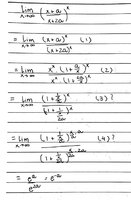Hello,
I've encountered this question in my calculus book, the image of the resolution is attached to this post.
I did not understand very clearly steps (2) and (3) (they are marked in the end of each equation).
I know that: the limit of (1 + 1/x)^x when x approaches infinity is equal to e. So, what I understood from this question is that I have to transform the equation until I can apply that rule, but I do not understand how X^x appeared, and how it developed into step (3).
Thank you.
I've encountered this question in my calculus book, the image of the resolution is attached to this post.

I did not understand very clearly steps (2) and (3) (they are marked in the end of each equation).
I know that: the limit of (1 + 1/x)^x when x approaches infinity is equal to e. So, what I understood from this question is that I have to transform the equation until I can apply that rule, but I do not understand how X^x appeared, and how it developed into step (3).
Thank you.
